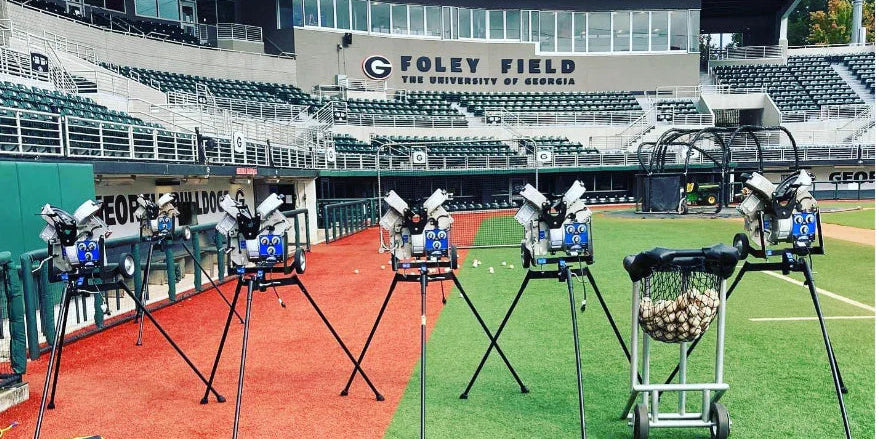Is a Pitching Machine Worth the Cost? We Say "YES"
Within the vast realm of sports equipment, one of the most intriguing inventions is undoubtedly the pitching machine. It's not just a device; it's an indispensable tool that has revolutionized the art of batting practice in baseball, and transcends the traditional boundaries of the game. When first conceptualized, it reimagined the way athletes could train, enhancing their skill sets and opening up opportunities for self-improvement.
The simple fact that a machine can consistently throw a ball with the same speed and trajectory, time after time, is fascinating. It also holds the promise of efficient, precise, and reliable training sessions. Whether you're a seasoned player sharpening your skills or a newbie getting acquainted with the game's mechanics, pitching machines stand as an essential part of your journey. They fuel your passion, foster your talent, and push the envelope of your potentials.
The Importance of Using Pitching Machines in Baseball Training.
The use of pitching machines in baseball training is an essential part of maximizing player potential. Not only do these machines provide consistent pitches enabling repeatable batting practices, but they also allow for customized speed and spin, crucial for mastering hitting techniques.
Incorporating pitching machines in training adds a degree of safety. Players are less likely to get hurt since pitching machines replace live-pitching sessions which might lead to injuries.
Moreover, these machines are not restrained by fatigue, thus prolonging training sessions and increasing productivity compared to a human pitcher. This allows more opportunities for players to improve their hitting skills and precision.
Utilizing pitching machines in baseball training is no indulgence, but a necessity for efficient and effective practice sessions. They contribute to enhancing player skills whilst promoting their safety, making them a valuable asset to any training routine.
Different Types of Pitching Machines: Understanding Your Options.
Choosing the right pitching machine can be overwhelming due to a plethora of options available. However, understanding the different types is the first step towards making an informed decision.
Wheeled pitching machines, one of the most common types, offers adjustable speeds and can pitch different types of balls. Arm machines, on the other hand, replicate the motion of a pitcher's arm, providing the most similar experience to a real pitch.
Compressed air machines utilize air to fire balls. They're reputable for their variable speed and easy maintenance. Then we have soft toss machines that throw lofted pitches, which are perfect for developing a hitter's swing and timing.
Finally, there are youth pitching machines, designed specifically for children with safety and simplicity in mind. All these devices serve different needs and picking the right one purely depends on your requirements.
Recognizing the Main Features of Pitching Machines.
Pitching machines come in a variety of styles, each equipped with unique features tailored to meet specific training needs.
Among the most common types are wheel-style and arm-style machines. Wheel-style machines are praised for their ability to change pitch speeds and types quickly, whereas arm-style machines mimic a real pitcher's arm action, offering a more realistic training experience.
Additionally, the power source is a crucial feature to consider. While most models are powered by electricity, there are also battery-operated machines that provide portability.
Finally, look out for pitching machines with adjustable pitch speeds, automated ball feeders for convenience, and the ability to use different ball types - all useful features that can elevate your training routine.
Understanding these features is key to determining which pitching machine is the right fit for your needs.
The Advantages of Using Pitching Machines for Skill Development.
Utilizing a pitching machine for skill development has several notable benefits.
First, it provides consistent, repeatable throws. This allows players to concentrate on form and technique, not on adjusting to different types of pitches.
Second, it facilitates efficient practices. Every minute counts in intensive training sessions, and using a pitching machine helps streamline practice and maximize the use of time.
Third, it also allows for personalization. Modern pitching machines can be customized to tailor a variety of pitches, which undoubtedly serves in honing a player's skills against varying pitch types.
Lastly, it mitigates the risk of injury. The pitching arm of a machine doesn’t tire or give into occasional erratic pitching, ensuring a safer practice environment.
All in all, implementing a pitching machine can significantly accelerate skill development for players at any stage of proficiency.
How to Choose the Right Pitching Machine for Your Needs.
Choosing the right pitching machine to meet your needs involves some significant considerations.
Firstly, analyze your skill level and future goals. Beginner players may opt for simple, one-speed machines, while advanced users may prefer multi-purpose devices.
Consider the types of pitches you want to work on. Some machines are versatile enough to pitch fast balls, curve balls, and sliders, among others.
Pay attention to the machine's speed range that matches with your needs. The right machine should challenge yet not overwhelm you.
Chosen a machine yet? Now, ponder over its portability and power source. If you're often on the go, a light-weight, battery-powered machine is your best bet. Conversely, for stationary use, a heavier, electric-powered machine will be the prime choice.
Remember, the right pitching machine lies on a broad spectrum between functionality and convenience to your preference.
Operating a Baseball Pitching Machine: Step-by-Step Guide.
Operating a baseball pitching machine can seem complex initially, but with a step-by-step approach, it becomes simpler.
Firstly, position the machine accurately on the pitcher's mound.
Next, adjust the machine's speed settings in line with the player's skill level.
Remember, the goal is to challenge, not overwhelm. Load the baseballs into the feeding system and ensure they feed smoothly into the machine; any hiccups could influence the pitch's accuracy.
Now, connect the machine to a power source and test a few balls before the actual practice begins. This ensures the machine is working correctly.
The last step is fine-tuning; adjust the pitch angle for practicing different hits.
Remember, safety is paramount. Always ensure that the area around the pitching machine is clear before operation.
Safety Tips and Precautions when Using Pitching Machines.
When using pitching machines, safety should always be paramount. Ensure you've read and fully understood the user manual before getting started.
Stay alert and always watch your surroundings. Note that pitching machines can throw balls at high speeds which could cause injury if not properly handled.
It's recommended to always wear protective gear, including helmets and batting gloves, even during practice.
Ensure the pitching machine is on level ground to prevent any sudden movement or tipping over.
Never leave the machine on and unattended, especially around children or pets who can accidentally knock it over or get hurt.
Regular maintenance and check-ups of the machine are essential. Loose screws or worn out parts can impact safety and performance.
Finally, carefully store away the pitching machine when not in use to avoid any unnecessary accidents.
Maintenance and Care: Prolonging Your Pitching Machine’s Lifespan.
Proper care and maintenance are essential to prolong the lifespan of your pitching machine. Make sure to clean the machine after each use, and store it in a dry and safe place. Lubricate moving parts regularly, according to the manufacturer's specifications.
Find the time to check for any visible signs of wear and tear. Always inspect wires and connectors for any issues. Remember not to overload your machine, and use only approved type and size of balls.
Annual professional inspection is also a good idea, tackling any small issues before they evolve into more serious ones. Be it spring-powered, air-powered, or electronic, your pitching machine will serve you reliably and consistently if given the needed attention and care


